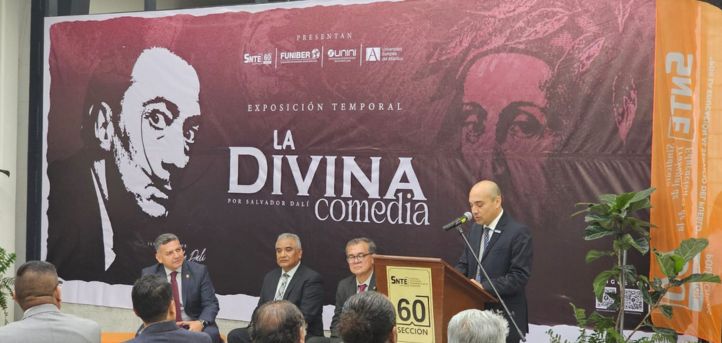FUNIBER’s Cultural Work and the European University of the Atlantic (UNEATLANTICO), in collaboration with the International Ibero-American University of Mexico (UNINI Mexico) and Section 60 of the National Union of Education Workers (SNTE), have inaugurated the exhibition “The Divine Comedy” by Salvador Dalí.
The exhibition, located in the facilities of Section 60 of the SNTE in Mexico City, can be visited free of charge from May 14 to May 31, Monday to Friday from 10:00 to 18:00 hours.
The opening ceremony was attended by Dr. Luis Alonso Dzul López, rector of UNINI Mexico, Carlos Gómez Rodríguez, secretary general of Section 60 of the SNTE, Javier Tapia Santoyo, secretary of administration of the National Polytechnic Institute (IPN) and Héctor Bello Ríos, director of Human Capital of the IPN.
Dalí’s “The Divine Comedy” collection is divided into three series of thirty-three works that portray the three cantos of Dante’s immortal poem and contain: Hell, Purgatory and Paradise.
The illustrations were commissioned by the Italian government to Dalí on the occasion of the 700th anniversary of Dante Alighieri’s birth in 1965. Upon receiving this important task Dalí declared that “it was one of the most important projects of his career”, as his work took him five years on the watercolors, supervising the woodcut plates one by one.
Woodcutting is a technique by means of which the design is printed on a piece of wood and then, with the help of a gouge, the image is carved manually, leaving the drawing in relief, to which ink will be added so that it will stand out. Therefore, the transfer involved 55 months of work by virtuoso craftsmen under Dalí’s supervision.
The collection of engravings presented was illustrated on wood in a 33 x 26 cm format using Vèlin pour chiffon de Rives paper, sealing its composition with a plate. Salvador Dalí’s signature was also stamped with a plate.
This exhibition continues its trajectory through Mexico, after having been exhibited at the Universidad Autónoma del Estado de México (UAEMéx) in March and April.


